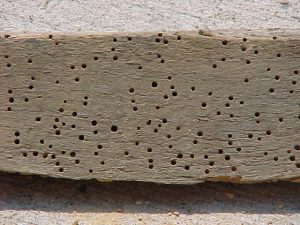WDI stands for wood destroying insect. An inspection for WDIs is commonly needed for the sale of homes. Most of the time, these inspections are not included in a general inspection of the home or always required but can prove beneficial before your new purchase. With a thorough inspection, WDIs and their damage can be brought to light and save buyers costly repairs in the near future.
An inspector must be certified through testing and on-site seminars with the office of the Indiana state chemist (OISC) to complete a valid NPMA-33 report. The certified inspector performs a visual inspection of all structures present on a property. In our service area, we are inspecting for evidence and/or damage caused by subterranean termites, powder post beetles, carpenter ants and carpenter bees.
Visual evidence of WDIs are most easily found in unfinished/exposed areas, but sometimes can be seen in areas with fixed wall coverings. It is important to note that no inspector has x-ray vision or can see behind fixed materials. Future remodels may expose a WDI issue that was inaccessible at the time of inspection. 
Subterranean Termites eat cellulose based materials (wood) for nutritional value. The termites themselves live underground and travel from the soil to their food source using shelter tubes. Their evidence can be found in any area throughout the home, but are most commonly found on lower levels or areas with exposed wood (garage, basement, crawlspace)
 Powder Post Beetle damage can be compared to “bird shot”. As they progress through their lifecycle, they bore into and out of wood beams creating tiny pinholes with fine powder protruding. They are found in damp areas such as cellars, crawlspaces and basements.
Powder Post Beetle damage can be compared to “bird shot”. As they progress through their lifecycle, they bore into and out of wood beams creating tiny pinholes with fine powder protruding. They are found in damp areas such as cellars, crawlspaces and basements.
Carpenter Ants will not eat the wood, but rather bore through to make their homes. A key indicator of these WDIs is seeing “frass”. As movement increases this frass will be forced through any possible opening. They can be found throughout the interior and exterior of homes.
 Carpenter Bees bore a perfect ½” hole in exterior structures. They are notorious for damaging decks, pergolas or any exterior wooden structure. After they vertically penetrate the surface, they will continue horizontally to make safe harborage for their eggs.
Carpenter Bees bore a perfect ½” hole in exterior structures. They are notorious for damaging decks, pergolas or any exterior wooden structure. After they vertically penetrate the surface, they will continue horizontally to make safe harborage for their eggs.
In conclusion, an inspection for WDIs can save homebuyers unwanted frustrations before the purchase of a new home. At the very least, they can expose a current/past pest issue, serve as a forewarning of problems yet to come, or influence purchase decisions. The cost of the inspection is minute compared to the tens of thousands of dollars in potential future repairs.








